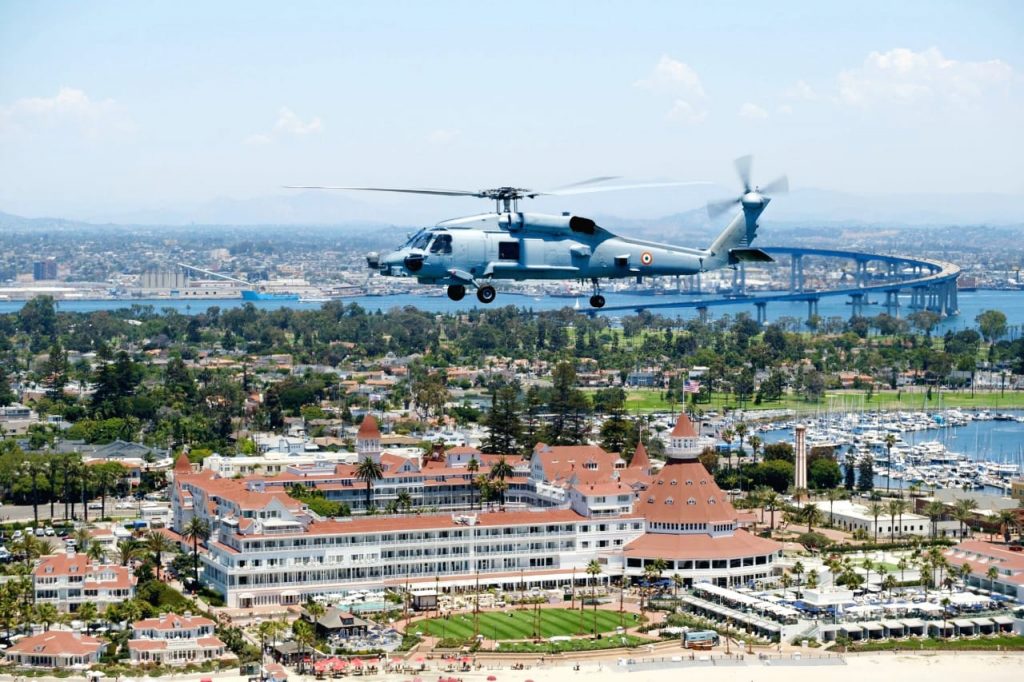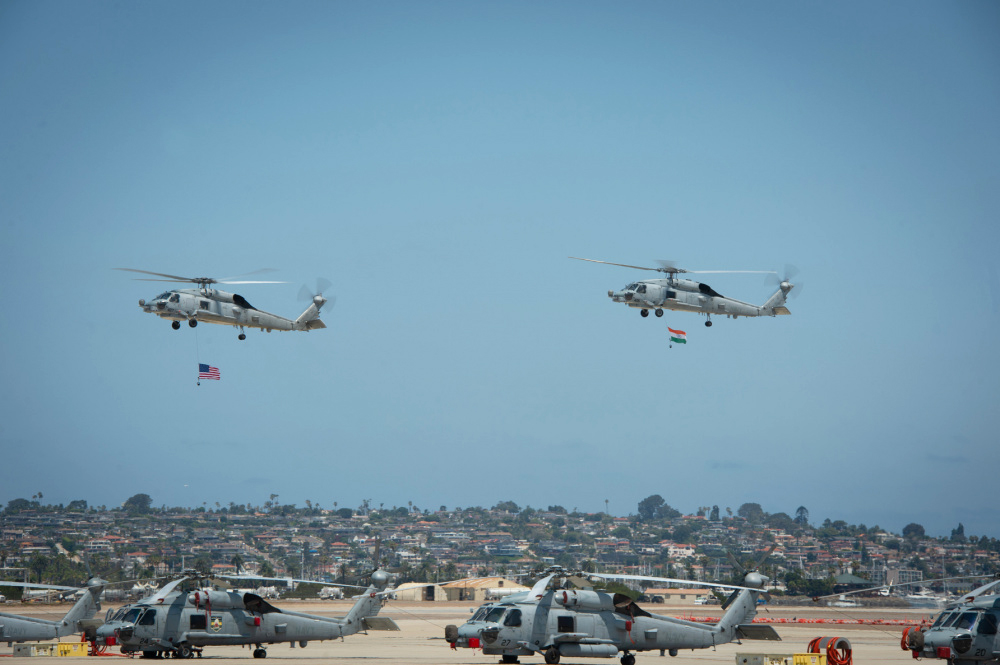Indian Navy Accepts First Romeo Helicopters
San Diego.
The Indian Navy accepted the first two of its MH-60R Multi-Role Helicopters (MRH) from the US Navy in a ceremony at the Naval Air Station North Island San Diego on July 16.
The ceremony marked the formal transfer of the helicopters from the US Navy to the Indian Navy which were accepted by Indian Ambassador Taranjit Singh Sandhu.
The ceremony also witnessed exchange of helicopter documents between Vice Admiral Kenneth Whitesell, Commander Naval Air Forces, US Navy and Vice Admiral Ravneet Singh, Deputy Chief of Naval Staff, Indian Navy.
According to Vice Admiral Shekhar Sinha (retd), former Flag Officer Commanding-in-Chief of the Western Naval Command, “The MH 60R will fill a critical capability gap in the armoury of the Indian Navy. With increased presence of non resident naval powers in the Indian Ocean, particularly submarines, it is essential for India to have state of the art Anti Submarine Warfare (ASW) helicopters.”
“Not only will they deter an adversary’s submarines but also give option to a Combat Task Force Commander to prosecute surface vessels in the same mission,” he added.
The MH-60R, manufactured by Lockeed Martin Corporation, is an all-weather helicopter designed to support multiple missions with state-of-the-art avionics/sensors.
Twenty-four of these helicopters are being procured under Foreign Military Sales from the US government. They are being modified with several India Unique Equipment and weapons.
Hamid Salim, Vice President, Sikorsky Maritime & Mission Systems, said: “The delivery of the first two MH-60R Romeo helicopters to the Indian Navy marks the beginning of a new era of collaboration and partnership between the United States Navy, the Indian Navy and Sikorsky. We are committed to stand shoulder-to-shoulder with the United States Navy to support the Indian Naval Forces in the future through capability upgrades and sustainment as the aircraft transitions to the Indian Navy.”

The US State Department had approved in April 2019 the sale of the MH-60R helicopters to India.
The Defense Security Cooperation Agency (DSCA) of the State Department announced approval on April 2, under the Foreign Military Sale (FMS) programme “for an estimated $2.6 billion” for the multi-mission helicopters. Procedurally, DSCA has to notify the US Congress, which it did, saying the proposed sale will strengthen the US-Indian strategic relationship and “improve the security of a major defensive partner which continues to be an important force for political stability, peace, and economic progress in the Indo-Pacific and South Asia region.”
This is the first time that the Indian Navy will get one of the most advanced Anti-submarine helicopters, equipped with Raytheon’s MK-54 torpedoes, Lockheed Martin’s Hellfire missiles, Advanced Precision Kill Weapon System (APKWS) and its Rockets, Night Fighting systems, sophisticated radars and secure communication devices. Just about the same that the US Navy uses.
The Indian Navy had decided around 2014 to go in for this helicopter, then Made and Sold by Sikorsky, and as usual there were procedural hiccups in India. Later, Lockheed Martin acquired Sikorsky, and the deal was closed.
Air Vice Marshal AJS Walia (Retd) and later Dr Vivek Lall, Lockheed Martin’s Vice President for Strategy and Business Development, coordinated the negotiations with Indian authorities. The Ministry of Defence then set up a Price Negotiations Committee (PNC) to finalise the deal.
As for the Weapons and Systems on board, DSCA said:
“The Government of India has requested to buy twenty-four (24) MH-60R Multi-Mission helicopters, equipped with the following:
“Thirty (30) APS-153(V) Multi-Mode radars (24 installed, 6 spares); sixty (60) T700-GE-401C engines (48 installed and 12 spares); twenty-four (24) Airborne Low Frequency System (ALFS) (20 installed, 4 spares); thirty (30) AN/AAS-44C(V) Multi-Spectral Targeting System (24 installed, 6 spares); fifty-four (54) Embedded Global Positioning System/Inertial Navigation Systems (EGI) with Selective Availability/Anti-Spoofing Module (SAASM) (48 installed, 6 spares); one thousand (1,000) AN/SSQ-36/53/62 sonobuoys; ten (10) AGM-114 Hellfire missiles; five (5) AGM-114 M36-E9 Captive Air Training Missiles (CATM); four (4) AGM-114Q Hellfire Training missiles; thirty-eight (38) Advanced Precision Kill Weapons System (APKWS) rockets; thirty (30) MK-54 torpedoes; twelve (12) M-240D Crew Served guns; twelve (12) GAU-21 Crew Served guns; two (2) Naval Strike Missile Emulators; four (4) Naval Strike Missile Captive Inert Training missiles; one (1) MH-60B/R Excess Defense Article (EDA) USN legacy aircraft.
“Also included are seventy (70) AN/AVS-9 Night Vision Devices; fifty-four (54) AN/ARC-210 RT-1990A(C) radios with COMSEC (48 installed, 6 spares); thirty (30) AN/ARC-220 High Frequency radios (24 installed, 6 spares); thirty (30) AN/APX-123 Identification Friend or Foe (IFF) transponders (24 installed, 6 spares); spare engine containers; facilities study, design, and construction; spare and repair parts; support and test equipment; communication equipment; ferry support; publications and technical documentation; personnel training and training equipment; US Government and contractor engineering, technical and logistics support services; and other related elements of logistical and program support.
“The total estimated cost is $2.6 billion.”
This article was published by India Strategic in July 2021.

